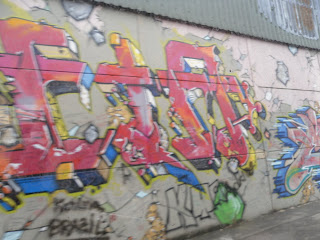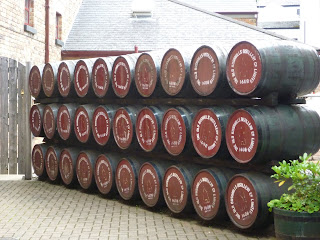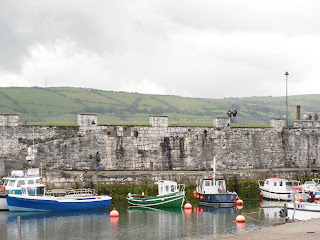JULY - 2011 NORTHERN IRELAND-UK /REPUBLIC OF IRELAND - (Click on Photos to enlarge)
Tuesday, August 16, 2011
Monday, August 15, 2011
Carrick-a-Rede Rope Bridge. Yes, we crossed it & returned safely. Watch the video (Last frame below)






 Carrick-a-Rede Rope Bridge is a rope suspension bridge near Ballintoy, County Antrim, Northern Ireland. The bridge links the mainland to the tiny Carrick Island. The site is owned and maintained by the National Trust, spans twenty metres and is thirty metres above the rocks below.
Carrick-a-Rede Rope Bridge is a rope suspension bridge near Ballintoy, County Antrim, Northern Ireland. The bridge links the mainland to the tiny Carrick Island. The site is owned and maintained by the National Trust, spans twenty metres and is thirty metres above the rocks below.
Watch the Video also.
Sunday, August 14, 2011
The Giant's Causeway & Legend of Finn McCool





The Giant's Causeway is an area of about 40,000 interlocking basalt columns, the result of an ancient volcanic eruption. It is located in County Antrim on the northeast coast of Northern Ireland, about three miles (4.8 km) northeast of the town of Bushmills.
Legend has it that the Irish warrior Fionn mac Cumhaill (Finn McCool) built the causeway to walk to Scotland to fight his Scottish counterpart Benandonner. One version of the legend tells that Fionn fell asleep before he got to Scotland. When he did not arrive, the much larger Benandonner crossed the bridge looking for him. To protect Fionn, his wife Oonagh laid a blanket over him so he could pretend that he was actually their baby son. In a variation, Fionn fled after seeing Benandonner's great bulk, and asked his wife to disguise him as the baby. In both versions, when Benandonner saw the size of the 'infant', he assumed the alleged father, Fionn, must be gigantic indeed. Therefore, Benandonner fled home in terror, ripping up the Causeway in case he was followed by Fionn.[citation needed]
Another variation is that Oonagh painted a rock shaped like a steak and gave it to Benandonner, whilst giving the baby (Fionn) a normal steak. When Benandonner saw that the baby was able to eat it so easily, he ran away, tearing up the causeway.[citation needed]
Another version of the legend was that Fionn had spent many days and nights trying to create a bridge to Scotland because he was challenged by another giant. A fellow boatsman told him that the opponent was much larger than he. Fionn told his wife and she came up with an ingenious plan to dress Fionn like a baby. They spent many nights creating a costume and bed. When the opponent came to Fionn's house; Fionn's wife told him that Fionn was out woodcutting and the opponent would have to wait for him to return. Then Fionn's wife showed him her baby and when the opponent saw him he was terrified at the thought of how huge Fionn would be. He ran back to Scotland and threw random stones from the causeway into the waters below.
The "Causeway" legend corresponds with geological history in as much as there are similar basalt formations (a part of the same ancient lava flow) at the site of Fingal's Cave on the isle of Staffa in Scotland
http://video.nationalgeographic.com/video/player/places/regions-places/europe-western/uk_giantscauseway.html
Friday, August 12, 2011
Wednesday, August 10, 2011
Tuesday, August 9, 2011
LARNE
Monday, August 8, 2011
Graffiti in Belfast





The Graffiti of the "Troubles". The principal issues at stake in the Troubles were the constitutional status of Northern Ireland and the relationship between the mainly Protestant unionist and mainly Catholic nationalist communities in Northern Ireland. The Troubles had both political and military (or paramilitary) dimensions. Its participants included republican and loyalist paramilitaries, the security forces of the United Kingdom and of the Republic of Ireland, and nationalist and unionist politicians and political activists.
Subscribe to:
Comments (Atom)










